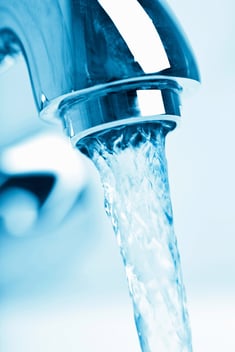According to the EPA, the average household uses about 260 gallons of water every day. Historically, home appliances have not been designed with efficiency in mind. But recent developments in water-efficient appliance design have made it possible for households to conserve significant amounts of water and energy used to produce water. For example, water can be saved by municipalities encouraging customers to repair leaky faucets, use high-efficiency washers, install reduced-flow toilets, and water lawns or gardens with a minimum amount of water. Utility companies can introduce water efficient products in their energy efficiency programs that help reduce the amount of energy used to heat water in the homes of their customers.
When choosing efficient appliances and fixtures for your water conservation program, look for the WaterSense® label: products with this label have been verified by the EPA and meet strict water efficiency and performance criteria. These products are guaranteed to help households save water, money, and energy.
Toilets are the largest source of water consumption at home, accounting for almost 30 percent of total indoor residential water consumption in the US. Older toilets use up to 3.5 gallons per flush. We have several products that can significantly reduce your customers’ toilet water consumption without having to replace the toilet: the 5-Year Toilet Flapper can prevent the wastage of up to 200 gallons of water a day caused by a leaky toilet flapper. To let customers determine if a toilet is indeed leaking, we offer Leak Detection Toilet Dye Tablets. These are simply placed in the toilet tank. If blue water appears in the toilet bowl, the flapper is damaged and needs to be replaced.
To reduce the amount of water used for each flush, the Water Bank™ Toilet Dam can be used to prevent one gallon of water per flush from leaving the tank, without affecting water pressure. An even simpler way to reduce water use is to hang a Toilet Tank Bank™ on the inside of the tank: these take up space and reduce the amount of water added to the tank after each flush. Finally, the Fill Master™ Fill Cycle Diverter can save 0.5 to 1.5 gallons of water per flush by diverting water from the toilet overflow back into the tank. All of these products are inexpensive and simple ways to reduce toilet water consumption and are well suited for any water conservation program.
Faucets account for more than 15 percent of all indoor household water use in the US. Your customers can reduce flow rates by 30 percent or more using WaterSense® labeled faucets. Another easy way to reduce flow rates is to replace the aerator. We carry aerators in a number of styles with flow rates from 2.2 to 0.5 gallons per minute. Water consumption in the kitchen can also be reduced by using the Dish Squeegee™ to wipe dishes clean instead of rinsing them before placing them in the dishwasher. In the U.S., showerheads account for about 17 percent of indoor household water usage. High-efficiency showerheads can reduce water flow rates by 25% – 60%. See our blog post on The 5-Minute Shower for information on how consumers can reduce water consumption in the shower.
In some hot and dry climates, household water use for outdoor purposes in the summer can exceed the amount of water used for all other purposes in the full year. Ensuring that your customers conserve water used outdoors is critical. Our Seven Spray Water Saving Garden Hose Nozzle can help regulate water flow to minimize wastage. Another tool to get customers to efficiently use water is our Garden Hose Timer; setting the timer to turn on in the morning will minimize the amount of water lost to evaporation. Finally, moisture meters can be used to prevent overwatering by displaying the moisture level at the roots.
When it comes to reducing water use at the residential level, there are plenty of options available for municipalities. Households that are equipped with efficient products and appliances can achieve significant water use reductions at low cost. Making consumers aware of their water consumption habits and the tools they can use to reduce consumption is an important first step. To insure that you’re keeping your water and energy use to a minimum, take a look at our Summer Weather Checklist.






